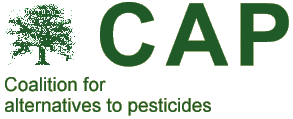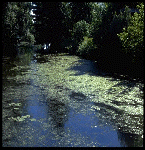|
|

|
 The Effects of Pesticides on the Environment The Effects of Pesticides on the Environment
- Water:
Samples from St. Lawrence tributaries contain many pesticides, often at levels higher than Environment Canada's Water Quality Guidelines (WQG) for aquatic life. (Especially in intense market gardening areas & close to fruit and vegetable processing plants.) In 1987 in the Yamaska River, for example, atrazine levels (WQG: 2µg/l) ranged from 2.1 to 17.5 µg/l, and 8/8 samples were above the WGQ. In the St. Regis River, Diazinon (an insecticide used on lawns and by farmers) (WQG: 0,08µg/l) was present at levels 75 and 300 times greater than the WQG. (5). Drinking water can also be affected. (4). In Saskatchewan, Environment Canada has regularly found 3 forms of PCBs, 7 herbicides, and 15 other pesticides in surface water samples. Temik, one of the most toxic insecticides used on potatoes, has contaminated 4000 wells on Long Island, and 25% of wells on PEI. (6). An EPA survey shows that Dacthal - a herbicide used on lawns and golf courses (widely used in Qu´┐Żbec) - is the most common pesticide in well-water. (12).
- Fish:
On 21 August 1991 the New York Times reported massive fish kills (750 000 dead fish) affecting over a dozen species in Louisiana. Pesticides used on sugar cane fields were implicated and temporarily banned. Eating contaminated fish is a risk for humans and animals. The New York State Department of Health, for example, recommends eating no more than one meal per week of fish from the state's freshwaters, due to contamination by industry, landfill leaks, and «widespread use of pesticides».
- The soil and its organisms:
With repeated applications of a pesticide, the soil can become conditioned, causing increasingly rapid degradation of pesticides. Target organisms may no longer be killed, so higher doses have to be used: a «chemical treadmill» is set up. (12). Pesticides in the soil also destroy beneficial arthropod populations, which include natural predators of pests. And they affect decomposers (eg. Earth worms, fly maggots, bacteria, fungi) responsible for soil replenishment through nitrogen circulation, cellulose decomposition, sulphur recycling, etc. (4,8,10)
- Pest resistance and resurgance:
Since the widespread use of chemical pesticides in the 1950s, more &more insects have become pesticide-resistant. By 1984 there were 447 resistant insect species. (12). With survival of the fittest, resistant insects pass on resistant genes to the next generation. A vicious cycle is set up, where more and more pesticides have to be used. (4). Secondary pest outbreaks can occur when pesticides affect the main pest, but not its competitor. The competitor then flourishes and threatens crops. Later, the main pest population resurges, and is present in higher densities than before treatment. (7). Sometimes, pesticides kill a predator and /or parasite which previously effectively controlled a pest. (8).
- Lawns:
Beneficial organisms (worms, fungi, bacteria, etc.) are destroyed by pesticides, causing an imbalance in the soil system, which may cause infertility, secondary pest outbreaks, resurgence of pests, & soil sterilization. (12). Treated lawns thus literally become chemically dependent or «addicted». It's ironic that people can actually damage their lawns in the pursuit of a «perfect lawn».
- People:
People can be exposed to pesticides at all stages of production, transportation, mixing, application and disposal. We are also constantly exposed to pesticides in the air, water and food. (7). A wide variety of acute and chronic health effects (see CAP News et Vous #2 re pesticide related cancers in pets.)
- Pets and wildlife:
May be damaged due to persistence and subsequent distribution of pesticides in air, water and via the food chain. (7). Vet Dr. Ann Huntington, a syndicated columnist, says pet symptoms after pesticide-exposure range from life threatening to acute allergic responses. She advises owners to keep pets away form treated areas for at least a week. (16). (See CAP News et vous #2 re pesticide related cancers in pets.)
- Pollinators
Bees (and honey), flies, birds, bats and moths are damaged or destroyed by pesticides. (3,7,8).
- Crops:
When Pesticides are used in excessive quantities, crop output can be decreased or an entire crop can be destroyed. If different pesticides are mixed, they may react and affect non-target crops and other plants. Side-effects can also result when wind carries pesticides to neighboring fields. A product that doesn't adversely affect potatoes, for example, can be harmful to corn. (4,7). When insecticides first became popular, US farmers used 50 million pounds per year and lost about 7% of crops to insect damage. By 1978, they used 600 million pounds and lost 13%.
- Birds' eggs:
Peregrine falcons became an endangered species when pesticide-contaminated prey caused thinning of eggshells and low levels of hatching. Abnormal behaviour (eg. Egg-eating) was also noted. The main problem was DDT, but newer, in-use products may also be harmful. Gannets were affected by DDT and dieldrin. (4.11). Hydrocarbon solvents used pesticides are highly toxic to birds' eggs (& aquatic life), and some components persist in the environment. (9).
- Birds:
Are affected in many ways. They breathe air, drink water and eat insects, seeds and fruits polluted with pesticides. Pesticides settle on their feathers, beaks and feet, to be ingested when they preen. They bath or swim in polluted water and dust-bath in polluted soil. Their nests are sprayed and residues are absorbed through eggshells or the skin of nestling. They feed their young contaminated insects and seeds: because of their small size they are at increased risk of poisoning. Pesticides can affect birds' ability to tolerate cold, and their hormone cycles which in turn control sexual development and maturation. Food sources are diminished, and sheltering pants are affected by pesticides. (2). Diazinon (widely used on West Island) is under EPA Special Review because of its killing of waterfowl and other bird species. Bird poisonings on residential lawns have been reported. (12). In a 1991 US study, only 12 of 42 peregrine pairs successfully produced young. (11).
- Pesticide drift:
Pesticides drift in the air and cause contamination far away. In many agricultural applications, more that 99% of applied pesticides drift off-target. In one study, 2,4-D was carried 16 to 80 km in the air. (12).
- Rain, snow, and fog:
Traces of organochlorine pesticides have been found in snow in NWT. (4). Fresh snow in the Rockies contains agricultural chemicals. (6). Alpha-BHC (which is no longer registered for use in Canada; it now originates from foreign sources) was found in Qu´┐Żbec rivers and in a very common contaminant of precipitation in Canada. (5).
- Global spread:
Given pesticide drift (see #12 above) and spread via precipitation (see #13), pesticide pollution is truly a global problem. Hence the presence of pesticide residues in arctic animals, for example. It is no longer reassuring to know that a particular pesticide is banned in some countries: we will still be exposed to it via spread from other countries. Researchers in Norway found DDT or its derivative DDE in crocodile eggs from remote regions in Kenya in polar bears and seals from the Arctic and in breast milk from women in Scandinavia and Zimbabwe. (13).
- Ozone depletion:
Methyl bromide, a widely used fumigant, accounts for about 10% of the annual depletion of the ozone layer. It breaks down ozone about 40 times as quickly as the now-notorious CFCs.
- Food chain poisoning:
Pesticide residues can accumulate in the food chin, causing damage to birds, fish and other animals. (3). (See #2 above re contaminated fish.) Because humans are so high on the food chain, we are at high risk. Young children and women of childbearing age have to be especially careful.
- Accumulation and persistance in the environnement:
As most pesticides are synthetic organic compounds that have no counterpart in nature, they are likely to accumulate in the environment. (7). Although DDT has not been used in Canada for over a decade, it is so persistent it still causes problems today and is present in water samples taken in Qu´┐Żbec. (4,5). But DDT is by no means the only persistent chemical. In 1990, soil and water samples taken before the application of pesticides for that season in Qu´┐Żbec potato farming district, Ste-Leonard d'´┐Żston, contained the hernbicide metribuzin (from the 1989 season).
- Creation of new poisons:
Several pesticides break down into even more hazardous compounds in the environment. For example, parathion (an organophosphorus insecticide) becomes a more toxic compound when it contacts oxygen. Also, there may be synergistic effects between two or more chemicals interacting in the environment.
Back to top
|
|
|
|
|
© 2000 Coalition for Alternatives to Pesticides
Webmaster: Shawn Buzzell
|
|



